Butterflies of the Adirondacks:
Baltimore Checkerspot (Euphydryas phaeton)
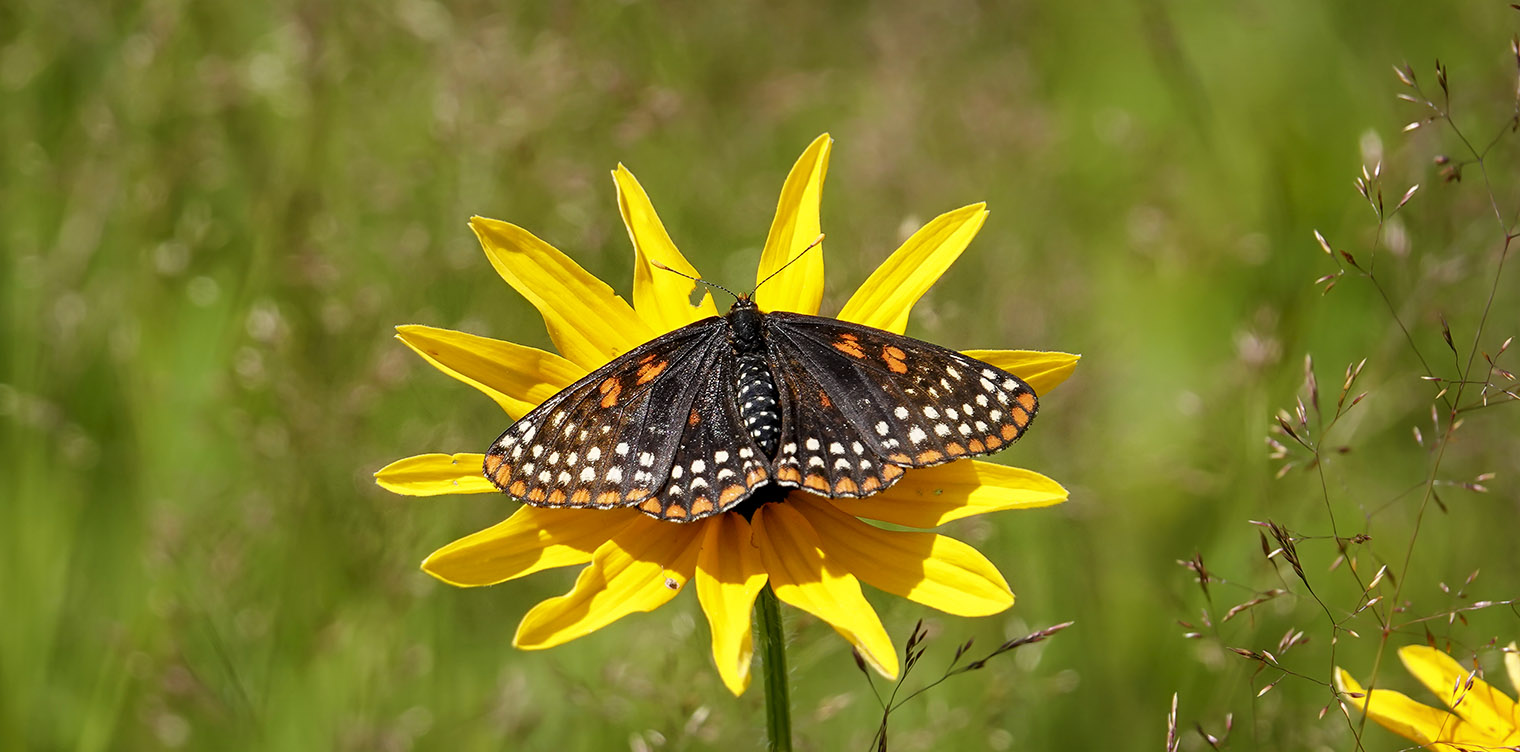
The Baltimore Checkerspot (Euphydryas phaeton) is a medium-sized, black and orange butterfly found near wet meadows or on old fields in the Adirondack Mountains of upstate New York.
The Baltimore Checkerspot is a Brushfoot butterfly, so named because of the reduced male forelegs. [1]
- The Baltimore Checkerspot is one of 21 species of Checkerspots. There are four other Euphydryas checkerspots: Anicia Checkerspot, Variable Checkerspot, Edith's Checkerspot, and Colon Checkerspot; all four are found in the western part of the US. [2] [3]
- There are two subspecies of Baltimore Checkerspot: Euphydryas phaeton ozarkae and Euphydryas phaeton phaeton. Ours is Euphydryas phaeton phaeton. [4]
The nonscientific name – Baltimore Checkerspot – is derived from the orange and black colors of the heraldic shield of George Calvert, the first Lord Baltimore. [5] Some older sources refer to the species simply as the Baltimore. [6] [7] The Baltimore Checkerspot is the state insect of Maryland. [8]
Baltimore Checkerspot: Identification
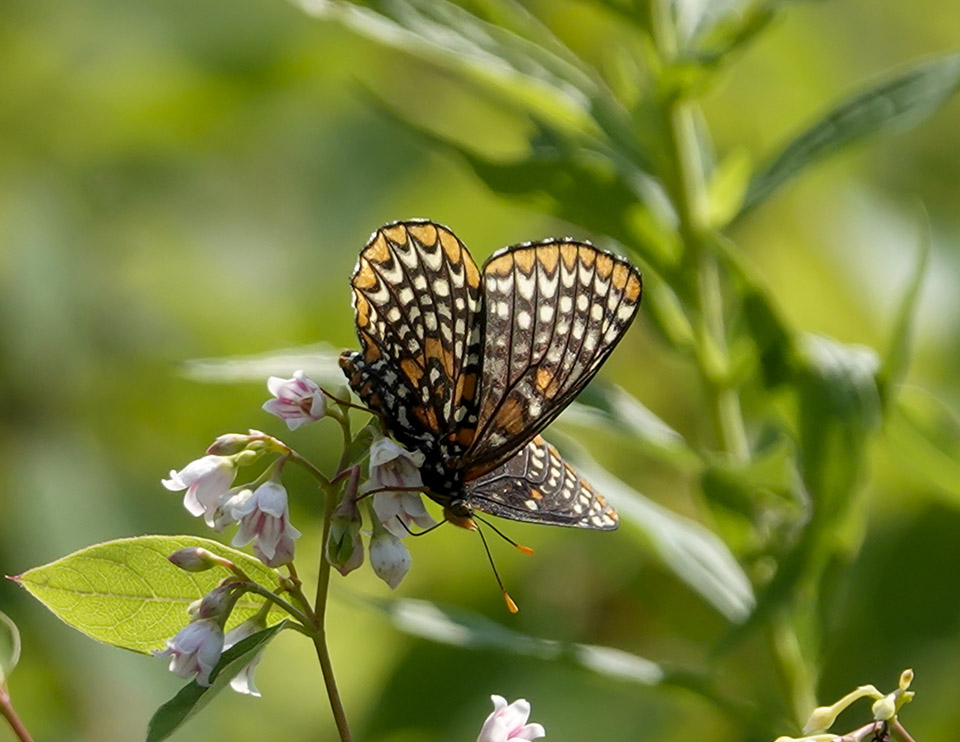
The adult Baltimore Checkerspot is a medium-sized butterfly with a wing spread of 1¾ - 2¾ inches. [9]
- From above, the wings are black with a row of deep orange crescents along the outer edges (marginMargin: The edges of the wing.). Above the crescents are several rows of white spots, with a few orange and white spots nearer the body. [10]
- The underside of the Baltimore Checkerspot is similar, but with more white and orange. [11]
- The antennae
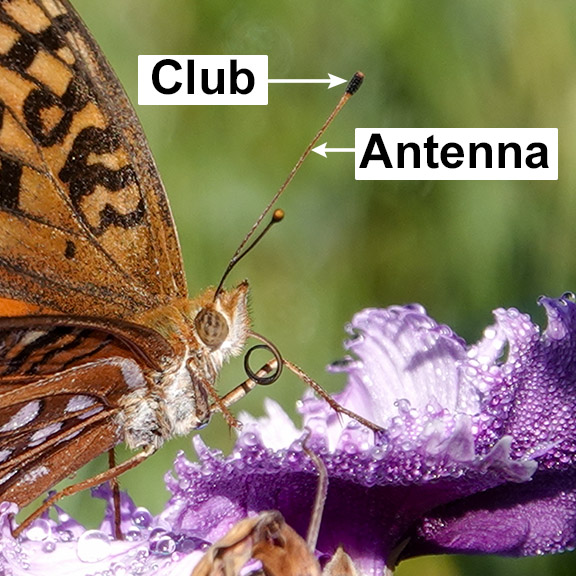 Antenna: One of a pair of long, slender sensory appendages on either side of a butterfly's head. are tipped with a bright orange clubs
Antenna: One of a pair of long, slender sensory appendages on either side of a butterfly's head. are tipped with a bright orange clubs Club: The thickened end of a butterfly's antenna.. [12]
Club: The thickened end of a butterfly's antenna.. [12]
The adult Baltimore Checkerspot can be distinguished from the slightly smaller Harris' Checkerspot (Chlosyne harrisii) by the amount of black on the wings. Harris' Checkerspots have much less black on both the upper and lower side of the wings. In addition, the upperside of the Harris' Checkerspot has a thick black line along the margin of the wings, contrasting with the bright orange crescents along the wing margin of the Baltimore Checkerspot.
The eggsEgg: Butterflies and moths develop through a process called metamorphosis, which entails four states: egg, caterpillar (larva), chrysalis (pupa), and adult. The egg is the first state in the life cycle. Female butterflies lay their eggs on the leaves of the host plant. Some species lay their eggs on the bottom of the leaf, others on flower buds, or at the base of a tree. Some species lay only one egg per plant. Others place a mass of eggs together. of Baltimore Checkerspot are dome-shaped with a depression on the top. [13] They are bright yellow when they are first laid, turning tan to red after a few days. [14]
The Baltimore Checkerspot caterpillar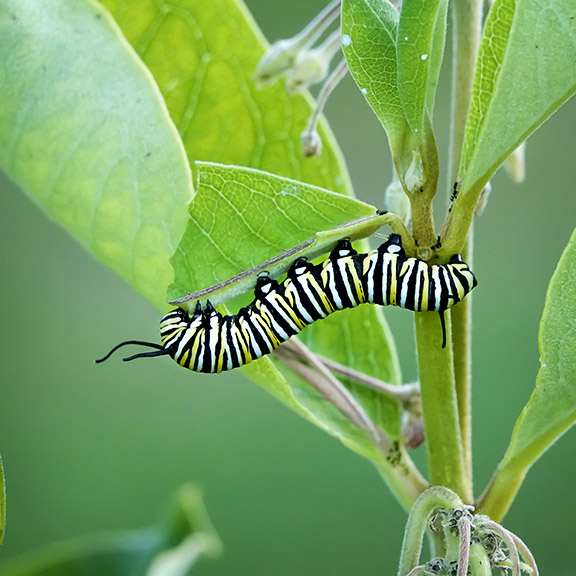 Caterpillar: Butterflies and moths develop through a process called metamorphosis, which entails four states: eggs, caterpillar (larva), pupa, and adult. The caterpillar, representing the second state in the life cycle, hatches from the egg. Its primary activity is eating. The caterpillars first eats its eggshell and then begins consuming the leaves on which the egg was laid. Newly-born caterpillars are very small and expand as they start growing. Because the exoskeleton does not stretch, the caterpillar grows by molting (shedding its skin). The stages between larval molts are called instars. is orange and black. [15] It has a series of alternating black and orange bands and conspicuous black spines. [16] [17] The head and rear are black. [18] The mature caterpillar is about one inch long. [19]
Caterpillar: Butterflies and moths develop through a process called metamorphosis, which entails four states: eggs, caterpillar (larva), pupa, and adult. The caterpillar, representing the second state in the life cycle, hatches from the egg. Its primary activity is eating. The caterpillars first eats its eggshell and then begins consuming the leaves on which the egg was laid. Newly-born caterpillars are very small and expand as they start growing. Because the exoskeleton does not stretch, the caterpillar grows by molting (shedding its skin). The stages between larval molts are called instars. is orange and black. [15] It has a series of alternating black and orange bands and conspicuous black spines. [16] [17] The head and rear are black. [18] The mature caterpillar is about one inch long. [19]
The chrysalisChrysalis: The hard outer shell of a pupa. (pupa) of the Baltimore Checkerspot is about ¾ inches. [20] It is bluish-white with raised black and orange bumps and smeared black spots. [21]
Baltimore Checkerspot: Life History
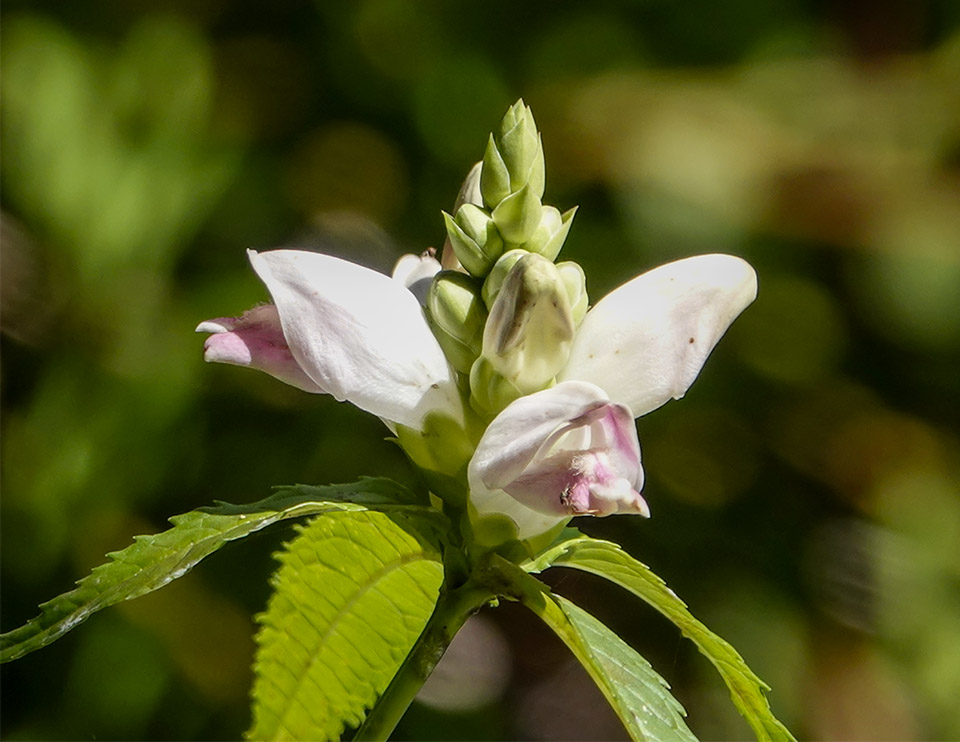
Female Baltimore Checkerspots lay their eggs in clusters of 100-700 eggs under host plant leaves. [22] The eggs hatch in about twenty days. [23] The newly-hatched caterpillars move to the tip of the plant and feed communally in a silken nest until August. [24]
At this time, the caterpillars stop feeding and thicken a section of the web, which serves them as a pre-hibernation web. This pre-hibernation web is sometimes constructed at the base of the host plant and sometimes found a short distance away. It is always constructed above ground level. Once the caterpillars enter their pre-hibernation web, they do not feed at all. [25]
Later in the fall (about the end of October in some regions), the caterpillars move together to the base of the plant, where they create a hibernation web by rolling up leaves and debris and fastening them with silk. [26] The caterpillars spend the winter in their hibernation web, overwintering as caterpillars (larvae). [27]
The caterpillars emerge in the spring to begin feeding again. [28] This usually takes place in late April or early May. The timing varies, depending on region. The caterpillar then forms a chrysalisChrysalis: The hard outer shell of a pupa., from which the adult Baltimore Checkerspot emerges after only ten days. [29] The timing of pupationPupation: The process of transformation from caterpillar to chrysalis. (the transformation into a chrysalis) varies, depending on region; some sources indicate that pupation occurs in May. [30]
The host plantHost Plant: The food plant of a caterpillar. Most species of butterfly will only eat a single plant (or group of related plants) as caterpillars. The particular plant that a caterpillar will eat is called the host plant for that species of butterfly. of the Baltimore Checkerspot varies, depending on the region and the availability of its preferred host: White Turtlehead (Chelone glabra).
- Female Baltimores reportedly prefer to lay their eggs on White Turtlehead, which is considered the primary host plant. However, when Turtlehead is not available, females will use the introduced species English Plantain (Plantago lanceolate). [31] [32]
- Both White Turtlehead and English Plantain contain chemicals called iridoid glycosides, which enhance larval growth and make them distasteful to birds. [33] [34]
Secondary host plants, on which the caterpillars may feed when older, include viburnums and honeysuckles. [35] [36] [37]
Adult Baltimore Checkerspots reportedly nectar on a variety of plants, including Spreading Dogbane, Common Milkweed, and Black-eyed Susan. [38] [39] A study of Baltimore Checkerspots in the Great Lake region suggests that adult Checkerspots are most active between 11:00 AM and 5:00 PM. [40]
Baltimore Checkerspot: Habitat and Range
Baltimore Checkerspots are found in the eastern United States and southeastern Canada. In the US, they are found west to the Great Lakes region and south through the eastern United States to northern Georgia, northern Mississippi,and northeast Oklahoma. [41] In Canada, this species is found in Nova Scotia, west through Price Edward Island and New Brunswick, along the Saint Lawrence River valley in Quebec, and throughout southern Ontario north to Algonquin Provincial Park. [42]
In New York State, there are currently only 92 verified sightings on the Butterflies and Moths of North America website. The sightings are mostly in the western and central parts of the state. There have been only six sightings in the Adirondack Park: in Essex, Franklin, and Herkimer counties. [43]
Baltimore Checkerspots were formerly restricted to damp meadows, shorelines, and marshy areas, where White Turtlehead grows. [44] [45] They can also be found in upland areas adjacent to wetlands. [46] However, since this species has expanded its host plant preferences to include English Plantain, it now also occurs in dry fields. [47] In some regions, dry fields with plantain represent the habitat where the Baltimore is most frequently found, sometimes in enormous concentrations. [48]
Baltimore Checkerspot: Flight
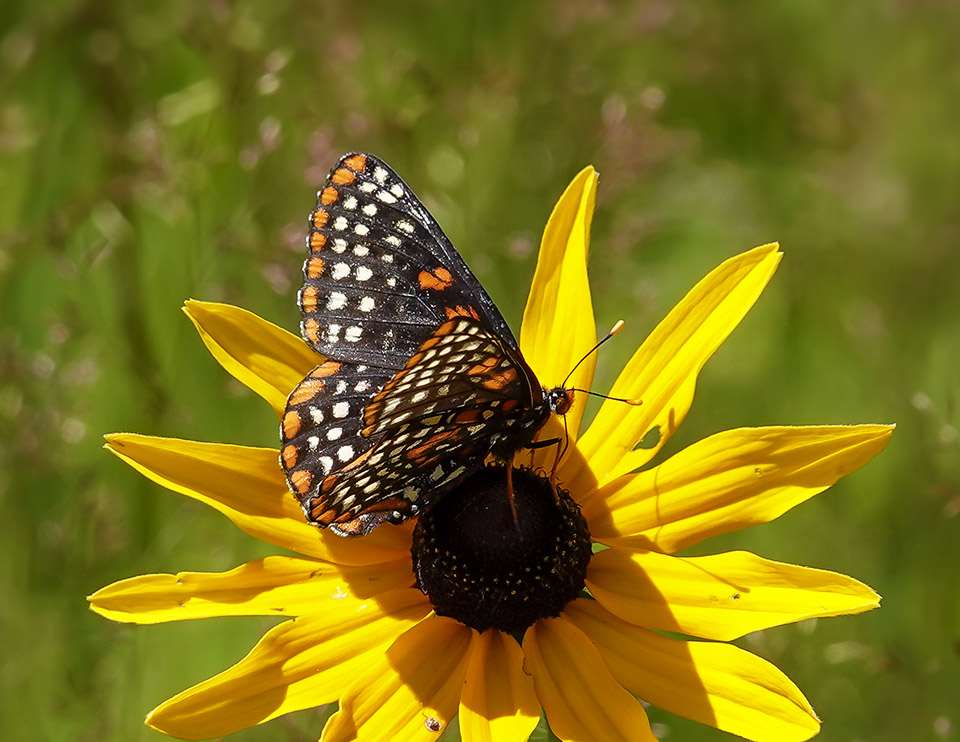
The flight period of Baltimore Checkerspots, as with all butterflies, varies with region and shifts from year to year. The Baltimore Checkerspot is univoltineUnivoltine: A butterfly which has one annual brood., which means that it has only one brood, flying from May through June in the southern parts of its range and in June and August in the northern parts of its range.[49]
- In Wisconsin, Baltimore Checkerspots fly from late June to late July, with weekly sightings peaking in early July. [50]
- In Massachusetts, this species has one brood and one concentrated flight period, with almost all sightings occurring between mid-June and mid-July. [51] [52] [53]
- In Vermont, the Baltimore Checkerspot's single brood typically flies from June to mid-August. [54]
- In Canada, the Baltimore Checkerspot's flight season is from mid-June to early August.[55]
- In the New York City region of New York State, the Baltimore Checkerspot flies mainly from mid-June through mid-July, with the largest number of sightings in the first half of July. [56]
The flight period and abundance of the Baltimore within the Adirondack Park can only be roughly estimated, based mainly on a very limited number of verified sightings on Butterflies and Moths of North America (BAMONA) and reported observations on iNaturalist.
- The advantage of iNaturalist is that it is a popular citizen science web site that attracts many observers, in part because it covers both plants and animals and in part because the process of submitting an observation is very easy. The disadvantage is that an individual observation can achieve "research-grade" status by being confirmed by the observer and one additional individual, who may or may not have expertise in that particular taxa.
- The advantage of BAMONA is that sightings are verified by regional specialists who are recognized experts. The disadvantage is that there are fewer sighting records for most species, partly because the site covers only butterflies and moths and partly because the process of submitting a sighting is more complicated.
- Both data sets share a common problem of citizen science: reported trends may reflect trends in the number of observers and their willingness to submit reports, not the abundance of the butterfly in question.
With these caveats in mind, it appears that Baltimore Checkerspots are most frequently seen in the Adirondack region in July.
- Baltimore Checkerspots have not been frequent guests at the Paul Smith's College VIC Native Species Butterfly House. This species was not listed as being present in the Species Logbooks for 2012, 2013, or 2016. It appeared only in 24 and 25 July 2014 and 1 and 2 August 2015.[57]
- BAMONA lists only a few verified sightings for Baltimore Checkerspots in the Adirondack Park, with six sightings of adult Checkerspots, all in July. [58]
- Similarly, there have been only seven observations of adult Baltimore Checkerspots in iNaturalist, one each in 2004, 2013, and 2014 (all in July) and none in 2016 and 2017. [59] [60] There was one iNaturalist observation in 2018, in mid-July in St. Lawrence County. [61] There were three observations of adult Baltimore Checkerspots in 2019, all in the last two weeks of July. [62]
References
- Susan Grimm Hanley. Interpretive Naturalist, Paul Smith's College Native Species Butterfly House. Species Logbooks.
- Butterflies and Moths of North American. Species Profiles. Baltimore Checkerspot. Euphydryas phaeton. Retrieved 13 October 2019.
- Butterflies and Moths of North American. Sighting Records. Baltimore Checkerspot. Euphydryas phaeton. Retrieved 13 October 2019.
- iNaturalist. Adirondack Park Sightings. Baltimore Checkerspot. Euphydryas phaeton. Retrieved 13 October 2019.
- iNaturalist. Adirondack Park Sightings 2016. Baltimore Checkerspot. Euphydryas phaeton. Retrieved 13 October 2019.
- iNaturalist. Adirondack Park Sightings 2017. Baltimore Checkerspot. Euphydryas phaeton. Retrieved 13 October 2019.
- iNaturalist. Adirondack Park Sightings 2018. Baltimore Checkerspot. Euphydryas phaeton. Retrieved 13 October 2019.
- iNaturalist. Adirondack Park Sightings 2019. Baltimore Checkerspot. Euphydryas phaeton. Retrieved 13 October 2019.
- Government of Canada. Canadian Biodiversity Information Facility. Species Bank. Baltimore Checkerspot. Euphydryas phaeton. Retrieved 13 October 2019.
- Massachusetts Butterfly Club. Massachusetts Butterfly Species List. Baltimore Checkerspot. Euphydryas phaeton. Retrieved 13 October 2019.
- Massachusetts Audubon. Butterfly Atlas Species Accounts. Baltimore Checkerspot. Euphydryas phaeton. Retrieved 13 October 2019.
- The Butterflies of Massachusetts. Baltimore Checkerspot. Euphydryas phaeton. Retrieved 13 October 2019.
- McFarland, Kent P. and Bryan Pfeiffer. Vermont Butterfly Survey. Vermont Center for Ecostudies – Vermont Atlas of Life. Baltimore Checkerspot. Euphydryas phaeton. Retrieved 13 October 2019.
- Integrated Taxonomic Information System On-line Database. Euphydryas phaeton. Retrieved 14 October 2019.
- Integrated Taxonomic Information System On-line Database. Euphydryas. Retrieved 16 October 2019.
- Iowa State University. Department of Entomology. BugGuide. Euphydryas phaeton. Baltimore Checkerspot. Retrieved 13 October 2019.
- Wisconsin Butterflies. Baltimore Checkerspot. Euphydryas phaeton. Retrieved 13 October 2019.
- Ross Layberry, Peter Hall, and Don Lafontaine. The Butterflies of Canada (University of Toronto Press, 1998), pp. 195-196; Plate 15, Figure 28; Plate 22, Figure 12, Plate 23, Figure 2.
- Thomas J. Allen, Jim P. Brock, James P. Brock, Jeffrey Glassberg. Caterpillars in the Field and Garden: A Field Guide to the Butterfly Caterpillars of North America (Oxford University Press, 2005), pp. 90-91.
- David L. Wagner. Caterpillars of Eastern North America: A Guide to Identification and Natural History (Princeton University Press, 2010), p.128.
- National Audubon Society. Field Guide to Butterflies (New York: Alfred A. Knopf, 1981), pp. 602-603; Plates 11, 21, 563.
- Jeffrey Glassberg. Butterflies of North America (Sterling Publishing Company, 2011), pp. 134, 138-139.
- Jeffrey Glassberg. Butterflies through Binoculars. The East. A Field Guide to the Butterflies of Eastern North America (Oxford University Press, 1999), pp. 100, 115-116. Plate 30.
- Jeffrey Glassberg. A Swift Guide to Butterflies of North America. Second Edition. (Princeton University Press, 2017), p. 208.
- Jim P. Brock and Kenn Kaufman. Kaufman Field Guide to Butterflies of North America (Houghton Mifflin, 2003), pp. 194-195.
- Paul A. Opler. A Field Guide to Eastern Butterflies (The Peterson Field Guide Series, Houghton Mifflin Company, 1992,1998), pp. 86-87, 260-261.
- James A. Scott. The Butterflies of North America. A Natural History and Field Guide (Stanford University Press, 1986), pp. 292-293, Plates 28 and 29.
- Donald and Lillian Stokes. Stokes Butterfly Book. The Complete Guide to Butterfly Gardening, Identification, and Behavior (Little, Brown and Company, 1991), pp. 78-79.
- Paul A. Opler and George O. Krizek. Butterflies East of the Great Plains: An Illustrated Natural History (The Johns Hopkins University Press, 1984), pp. 149-150, Plate 27.
- Rick Cech and Guy Tudor. Butterflies of the East Coast. An Observer's Guide (Princeton University Press, 2005), p.179.
- Nancy E. Stamp, "Effect of Defoliation by Checkerspot Caterpillars (Euphydryas phaeton) and Sawfly Larvae (Macrophya nigra and Tenthredo grandis) on their host plants (Chelone spp.)," Oecologia, Volume 63, Number 2 (1984), pp. 275-280. Retrieved 9 October 2019.
- Nancy E. Stamp, "Parasitism of Single and Multiple Egg Clusters of Euphydryas phaeton (Nymphalidae)," Journal of the New York Entomological Society, Volume 89, Number 2 (June 1981), pp. 89-97. Retrieved 14 October 2019.
- Nancy E. Stamp, "Aggregation Behavior in Baltimore Checkerspot Caterpillars, Euphydryas Phaeton (Nymphalidae)," Journal of the Lepidopterists' Society, Volume 36, Number 1 (1982), pp. 31-41. Retrieved 13 October 2019.
- M. Deane Bowers, Nancy E. Stamp and Sharon K. Collinge, "Early Stage of Host Range Expansion by a Specialist Herbivore, Euphydryas Phaeton (Nymphalidae)," Ecology, Volume 73, Number 2 (April 1992), pp. 526-536. Retrieved 15 October 2019.
- M. Deane Bowers, "Unpalatability as a Defense Strategy of Euphydryas phaeton (Lepidoptera: Nymphalidae)," Evolution, Volume 34, Number 3 (May 1980), pp. 586-600. Retrieved 14 October 2019.
- M. Deane Bowers, "Over-Wintering Behavior in Euphydryas Phaeton Nymphalidae)," Journal of the Lepidopterists' Society, Volume 21, Number 4 (1978), pp. 282-288. Retrieved 13 October 2019.
- Patricia M. Durkin, "Efforts to Restore the Baltimore Checkerspot (Euphydryas phaeton) in Maryland," News of the Lepidopterists’ Society, Volume 51, Number 1 (Spring 2009), pp. 3-4, 31. Retrieved 14 October 2019.
- Brian G. Scholtens, "Host Plants and Habitats of the Baltimore Checkerspot Butterfly, Euphydryas Phaeton (Lepidoptera: Nymphalidae), in the Great Lakes Region," The Great Lakes Entomologist, Volume 24, Number 4 (Winter 1991), pp. 207-217. Retrieved 13 October 2019.
- Jennifer Frye (ed.), Conservation and Management of the Baltimore Checkerspot (Euphydryas phaeton Drury) in Maryland: Strategies for Statewide Monitoring and for Wetland Restoration, Captive Breeding and Release in the Piedmont Region (Maryland Department of Natural Resources, September 2013). Retrieved 16 October 2019.
